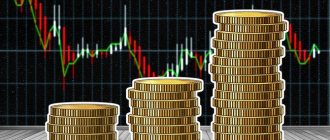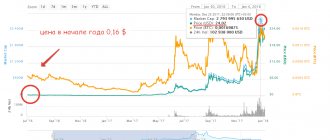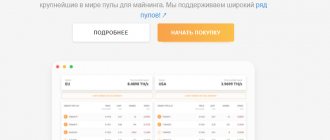Most successful traders understand that the more they invest, the higher the income they receive. Therefore, they use reinvestment of profits or, in other words, acceleration of the deposit, a simple and effective way to increase capital. The essence of this method is to reinvest profits in the same financial instruments in which capital was originally invested, or in other assets. There is also a mixed option, when part of the profit is invested in the same products, and the second part in new ones. However, it is worth noting that you should not reinvest 100%; this entails great risks and significant losses.
Reinvestment - what is it in simple words
The term “reinvestment” is a derivative word originating from the English “invest” (to invest money), with the prefix “re” denoting repetition of the action.
In simple terms, reinvestment is the reinvestment of profits earned from previous successful investments. The process can be represented as the use of dividends, interest paid, and other income distribution options.
Example: You opened a bank deposit in the amount of 1 million rubles at an annual rate of 5%. A year later, we received an income of 43,500 rubles. (50,000 – 13% tax). You can withdraw this money and spend it on personal needs. But if you leave this money and extend the deposit agreement for another year, then interest will be accrued on the amount of 1,045,500 rubles. and income at the end of the second year will be 52,275 rubles. (minus 13% tax) = 45,479.25 rubles.
Depending on the share of reinvested funds from the total amount of profit, a distinction is made between full or partial investment. It is impossible to predict the profitability of reinvestment in advance, but the investor has the power to manage the process by adjusting the timing, amount, chosen instruments, and external circumstances.
Reinvestment is the practice of using dividends, interest, or any other form of income received from an investment to generate new income through the purchase of shares, shares, or other assets, rather than simply spending the earnings.
Let's take a closer look at the principles of reinvestment and the factors influencing its final result.
Principles of reinvestment
If you are planning to reinvest your profits with the intention of increasing your total income, consider how to do this with minimal risk of loss while receiving stable income. To increase your chances of successful reinvestment, follow three basic principles:
- For investments, use only available funds. If you are not sure that you will need the money you are investing in in the near future, or some of it, you should not reinvest the profits. To reinvest, take as much money as you can save for the long term.
- Diversify your investments. The golden rule of an investor is to diversify capital by introducing variety into financial instruments. A balanced portfolio is the best protection against sudden market movements and losses. While one asset falls in value, the rest grow and generate income.
- Make sure your investments generate income without exposing your entire capital to excessive risk. A professional manager can help you choose instruments and investment strategies if you are unable to delve into the nuances of stock trading on your own.
As with initial investment, you need to reinvest wisely, choosing the safest and most promising assets, avoiding overly risky transactions.
Mechanism of action
I read a very instructive story that well illustrates the mechanism of compound interest.
One young African American woman deposited $5 a week from her modest salary into a bank account. History is silent at what percentage, but this is not important now. The main thing is that every Thursday she went to the bank and deposited money into her account. And this went on for 62 years. After this period, she had accumulated $250,000, which she divided as follows:
- I gave 10% to the church;
- 20% was given to children and grandchildren;
- I kept 20% for my living;
- She gave 50% to a large university, which has since been paying scholarships in her name to poor black students.
The amount of profit depends on the interest rate (coupons, dividends), the amount of the initial and subsequent investments, the frequency of interest accrual and the investment period. The greater the listed parameters, the greater the income the investor will receive. Let's look at how the mechanism works using the example of three strategies:
- A 30-year-old man invests 100,000 rubles. for 30 years at 10% per annum. Does not withdraw income or replenish capital. At the age of 60 he receives the full amount.
- The same man, but annually he plans to top up his account by 50,000 rubles. Other conditions do not change.
- A man opens an account for his 10-year-old daughter and deposits only 10,000 rubles into it. at 10% per annum with an annual replenishment of 10,000 rubles. First the father, and then the daughter herself, strictly follow the plan. The daughter plans to save until her 60th birthday, i.e. 50 years.
Let's see who will save more for their anniversary, provided that income is accrued once a year.
| 1st option | 2nd option | 3rd option |
| 1 744 940,17 | 9 969 558,58 | 12 812 878,19 |
Compound interest works not only on deposits, but, as I already said, in other instruments as well. Each of them has its own nuances, and we will consider them.
But first, one more historical example. Benjamin Franklin bequeathed $5,000, which he deposited in bank accounts, to two American cities. He set the condition that after 100 years they would withdraw $500 thousand, and the entire amount only 200 years after his death. B. Franklin died in 1791. After 100 years, each city received half a million dollars, and after another 100 years, $20 million.
Where can you reinvest your profits?
If people knew for sure where it is better to invest their money, the world of investments would lose its sharpness and unpredictability. However, where we are talking about millions of investors with their own thoughts, desires, and willingness to take risks, it is impossible to dictate the dynamics and calculate future profits in advance. Let's look at the most common options where today's investors usually reinvest profits.
Real estate
It is impossible to avoid mentioning real estate when we talk about possible investment returns. In the context of the unfolding crisis in the real estate market, in 2022 they launched a preferential mortgage project, which made it possible to take out large loans from banks at 5-6% per annum in conditions of increasing inflation and depreciation of the ruble. Thousands of middle-income families without large savings bought new apartments, causing a new increase in housing costs. Over the year, in different regions of the country, the increase in real estate prices reached 30-80%.
Reinvesting in real estate can be thought of as purchasing a new home using funds earned from property appreciation. Since housing tends to rise in price, and a fall in price is unlikely, this reinvestment option will seem profitable to many.
Deflation - what is it and why is it worse than inflation?
Bank deposits
Unlike real estate, where reinvestment requires large sums, a bank deposit with capitalization is considered an accessible and understandable option for reinvesting funds.
A deposit with interest capitalization allows the investor to receive a bank-guaranteed income of 3-12% per annum, earning an additional amount by adding accrued interest to the main deposit.
Scheme of how a bank deposit works with capitalization:
- The bank charges interest.
- The amount is added to the main deposit (capitalized).
- Next month the bank will charge interest on the increased deposit amount.
To understand the advantage of a deposit with capitalization, try using a deposit calculator. The longer the period of storage of funds on such a deposit, the greater the difference between the income from a regular deposit and a deposit with capitalized interest.
For example, for an amount of 100 thousand rubles at 10% over 5 years, 61.05 thousand rubles will be charged. If you refuse capitalization, the bank will accrue only 50 thousand rubles (10 thousand for each year of storage). Over 5 years of deposit, income from reinvestment of interest will amount to more than 11 thousand rubles.
Interest capitalization is not the only way to reinvest. The investor can direct interest from the deposit to other projects, receiving additional income.
Usage
Currently, the reinvestment process is actively used all over the world. Its use contributes to a significant increase in the profitability of the initial investment and does not depend on the starting size. Each time you replenish your deposit, you should remember that funds are added to the initial investment, and interest is calculated on the amount that was formed after replenishing the account.
Many banks offer exclusive conditions for depositors, involving reinvestment of profits, thereby creating mutually beneficial cooperation between the investor and the bank. For any investor, the possibility of reinvesting interest is a real chance to increase the amount of initial capital in a short period of time, receiving funds that provide passive income.
Reinvesting is considered a simple and effective way to increase capital, which is used by most successful investors who understand that the more money they invest, the more profit they will receive. The essence of reinvesting profits is to reinvest them in the same assets where the initial investments were made or in some other financial instruments.
If we consider the first case, here the interest is calculated on the new, replenished amount; in the second case, the investor is given the opportunity to choose riskier and more profitable investments. There is also a mixed option, which involves reinvesting one share of profits in the initial investment, and the other share in new investment products. In addition, reinvestments can be focused both on a long period of time and on the use of short-term speculative tactics.
What is the reinvestment ratio and how to calculate it
To evaluate the results of a company's commercial activities, they often use the reinvestment ratio (Retention Ratio). This term refers to a profitability indicator that helps evaluate the current profit distribution scheme.
The higher the ratio, the greater the percentage of profit allocated to investment in the company. A high indicator may mean that the company is intensively conducting production and sales activities, replacing sources of financing with cheaper ones, and updating equipment.
The optimal value of the ratio in the eyes of the company management will be 100%. For stock owners, it is best if the indicator value is 0%. A zero coefficient will mean that all net profit earned will be used to pay dividends. If the indicator is less than zero, the company has financial problems. If the company's net profit exceeds 100%, it is not the only parameter that leads to an increase in reserve capital and retained earnings.
The average values of the coefficient differ according to the areas of activity of companies. For example, technology companies typically have a coefficient of about 100% due to the lack of dividends, since all earned profits are used for development. Telecoms and utilities have lower reinvestment rates because dividends are more important to attract new shareholders.
To calculate the reinvestment ratio, from the amount of reserve capital and retained earnings at the end of the reporting period, you need to subtract the amount of reserve capital and retained earnings at the beginning of the reporting period, divide the resulting difference by net profit at the end of the period and multiply by 100%.
You can calculate this ratio in relation to dividends and earnings per share:
- Retention Ratio = (Earnings per share – Dividend per share) / Earnings per share
Calculation example: According to the balance sheet, Company A reported 873 thousand rubles at the beginning and end of the reporting year. reserve capital. Retained earnings at the beginning of the period amounted to 904 thousand rubles. against 723 thousand rubles. at the beginning of the period. Net profit at the end of the period amounted to 307 thousand rubles. Let's calculate the reinvestment ratio = (873+904-873-723)/ 307*100% = 58.96%.
Calculation formulas
When calculating the profit from financial investments, a compound interest calculator will help you. However, you can calculate the profitability yourself using the formula:
FV = PV * (1+i)^n , where: FV is the amount of income you will receive after reinvestment; PV is the starting capital with which you start investing; i is the percentage at which you deposit funds; n is the time period during which you plan to reinvest.
When calculating compound interest in relation to deposits, the bank uses a more complex formula:
FV = PV * (1+p*d/y)^n , where: p - interest rate for the entire period of the deposit; d is the number of days for which interest is calculated; y is the total number of calendar days in a year.
Using this formula, you can calculate the rate for any specific deposit period.
If you want to invest in a company's shares, you should first assess its financial condition. The reinvestment ratio will help you with this, which can be calculated using the formula:
RR= (P-D)*100%/(O+Inv+PA+RK) , where: RR - reinvestment ratio; P is the company’s profit for a certain period; D is the amount of dividends that the company pays; О - total cost of equipment taking into account depreciation; Inv - volume of investment; PA - other assets; RK - working capital.
Reinvestment of excess income in Russia
The concept of reinvesting excess income appeared in 2022, when, after a difficult “pandemic” year in all respects, companies in the metallurgical industry received a multiple increase in income. NLMK, Severstal, MMK, against the backdrop of rising world prices in ferrous and non-ferrous metallurgy, reported a 4-fold increase in profit in the 1st quarter. 2021
In May 2022, against the backdrop of fresh quarterly reports from metallurgists, Deputy Chairman of the Government of the Russian Federation Andrei Belousov said that companies in this industry had “struck” the state for 100 billion rubles, but it has the right to set taxes in such a way as to take away the excess profits received.
The situation was fueled by the rapid rise in prices in the construction industry and accusations that metallurgists were facing about the rise in metal prices on the domestic market, which led to an increase in costs for government contracts.
Statements from metallurgists about the need for technological and production modernization, the need to finance environmental protection and the development of social infrastructure were heard, but by the end of June 2022, the mechanism for withdrawing “extra profits” was nevertheless launched in the format of an export duty, complementing the one already carried out this year 3 ,5-fold indexation of mineral extraction tax. According to A.R. Belousov, metallurgists were expected to return 164 billion rubles, which would have amounted to approximately a fourth or fifth of the entire industry “excess profit.”
For the state, the imposed duties would become another revenue item in the budget, temporarily restraining further price increases. For metallurgists, they would mean a refusal to invest in development for the coming years. In an interview with Interfax, NMLK directly stated that the state’s goal is “direct withdrawal of funds,” and the duty itself will not be able to increase supplies within the Russian Federation and will not reduce prices for the ordinary consumer.
The head of Severstal, Alexey Mordashov, acted as a conciliator for the parties, saying in an interview with the Financial Times that his company would respond to the president’s call to reinvest excess profits, instead of paying high dividends to shareholders. The head of one of the country's largest metallurgical companies called on big business to respond to the president's call by satisfying the existing “demand for social justice.” In fact, Severstal was the first to confirm the willingness of businesses to pay for the right to conduct their activities, but it is better to do this through reinvestment of profits, and not through a new tax burden.
Refusal of capitalization
When investors deliberately refuse to reinvest profits, they lose out on the opportunity to achieve maximum returns. In this case, the main task of financial transactions related to capital investments is lost. Beginners who are just mastering investment activities need to remember about the balanced formation of an investment portfolio. It is ideal when the portfolio is filled with investment instruments that complement each other in critical situations.
Refusal to reinvest is justified when the investor is offered to invest in a dubious and unfamiliar financial instrument or project. In such a situation, you must refuse, as this may be a fraudulent scheme, the main goal of which is to collect funds from gullible people. To avoid becoming a victim of scammers, you need to regularly monitor financial markets.
You should cooperate only with trusted managers who have repeatedly proven their professionalism in the field of investment. Timely precautions taken will help not only save money, but also increase it.
Digital reinvestment
Digital reinvestment is a term that appeared with the emergence of the digital sphere and IT technologies. It means directing the income received from the digitalization of the economy into five basic areas: 1) infrastructure, 2) information security, 3) personnel and education, 4) regulatory regulation and 5) research and development.
Let’s imagine that, as part of its activities, a company manually processes requests received from clients, and competitors have introduced auto-sorting technology for calls, allowing them to report what kind of problem has arisen by selecting a menu command. While 5 operators manually served 10 clients, the automenu system redirected calls from 20 clients, distributing them among specialists from different departments. After some time, the same company set up the chatbot, relieving the phone line. Since 8 out of 10 requests sounded the same, we introduced a chat form where clients received information around the clock, following a certain algorithm.
Competition with such a “digital” business is doomed to failure with a company that ignores the request for digitalization quickly withdrawing from the race.
In the age of rapid advancement of technology, we can only observe how a “digital man” is formed from a “homo sapiens”, capable of interacting virtually or remotely with authorities, employers, clients, etc. Staying digital is a vital requirement for running a business, whether it's tax filing or customer service.
Digitalization of the economy is an inevitability, without which it is almost impossible to achieve success in the modern world. By investing in digitalization, we are creating a platform for revenue growth and strengthening business competitiveness in the near future.
What is liquidity: instructions for calculating the liquidity ratio, formulas and analysis with examples
According to a study conducted by the PwC group, in 2022, Asian countries became the leaders in digitalization, where 19% of participants confirmed a high level of technology and the status of “Digital Champion”, when only 5% of participants from European countries could boast of similar achievements. Most companies have been forced to invest in new technologies by the rapid rise in production and labor costs. To maintain competitiveness, Asian companies are forced to spend part of their profits on digitalizing production processes.
According to a survey conducted among 1,155 companies, researchers from PwC found that on average, digitalization participants in the next 5 years expect to receive additional revenue of 14.7% from the implementation of digital technologies in the coming years.
Intending to become part of the common digital space, Russia is taking restrained steps towards mastering the “digital”. According to the publication of the study “Russia Online?”, in 2016 the share of the digital economy was only 2% of GDP, with average annual dollar growth for the period 2010-2016. at 4.8%. This is lower than in Scandinavia, where growth was around 7%, or in the US, with annual growth averaging 8-9%.
They started talking seriously about digital reinvestment in Russia after the approval of the “Digital Economy of the Russian Federation” program on July 28, 2017, highlighting 5 basic areas of digitalization:
- Infrastructure.
- Information Security.
- Personnel and education.
- Regulatory regulation.
- Research and development.
Participants in the autonomous non-profit organization “Digital Economy” included Russian IT giants, operators, Sberbank, Russian Post and a number of state corporations.
Digital reinvestment was highlighted as one of the tools of the digital economy. Taking on the role of an investor, the state directs the income received to selected basic areas - education, healthcare, infrastructure.
The housing and communal services sector has experienced big changes, where long queues at cash desks to pay receipts have been replaced by convenient payment of receipts through an application or personal account on the management company’s website. The introduction of online transmission of meter readings made it possible to reduce costs for the utility consumption metering system.
In the context of the 2020-2021 pandemic, the ability to remotely contact authorities and government departments through State Services, and connect to the Yandex.Textbook educational platform, through the Unified Identification and Authentication System (USIA), has acquired particular value.
The user of the ESIA system gets access to several resources at once: State Services, Pension Fund, Federal Tax Service, GIS Housing and Communal Services, the Work of Russia portal with the ability to contact employment centers to assign unemployment benefits, regional departments, appointments with medical specialists under the compulsory medical insurance policy, etc.
The State Services platform has significantly expanded its functionality in recent years - in 2022, the “electronic voting” project was successfully developed, and in 2022 everyone could participate in the population census. There is every reason to believe that the potential of the State Services and ESIA platform is far from exhausted, and will further contribute to a reduction in budgetary expenses for servicing citizens.
Question answer
We have prepared answers to the most common questions that investors have when reinvesting.
What is reinvest
This is short for the term reinvestment. The meaning of this concept is the same, reinvest is the repeated investment of funds in the same asset in order to further increase the income from it.
What is loan reinvestment
Loan reinvestment most likely means refinancing, i.e. a banking program that allows you to renegotiate loan terms by lowering the rate or increasing the repayment period.
The main goal of loan refinancing is to reduce the borrower’s monthly payment and/or reduce the final overpayment of interest to the bank.
You can refinance a loan at your bank, but more often these programs are designed for borrowers from other credit institutions who are attracted by the idea of reducing the overall cost of servicing their loan debt.
Due to the peculiarities of annuity payments, you should refinance a mortgage or other loans with a fixed payment amount in the first half of the repayment, since the main overpayment of interest falls precisely on the initial period of lending.
PAMM accounts
PAMM accounts are a well-known and accessible reinvestment option. It does not require large capital at the start.
Advantages of PAMM accounts:
- The client can always withdraw funds, and he can also top up his account at any time.
- In addition to the investor’s funds, the account also contains your own money.
- The main advantage is the low level of initial capital.
Advice! For the safety of funds, it is necessary to distribute them between different accounts. Do the so-called diversification of capital.









